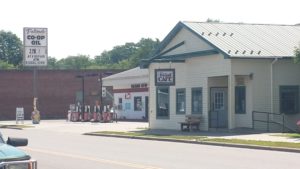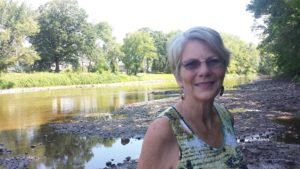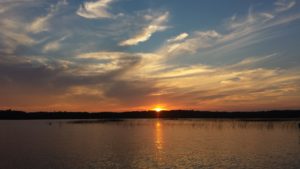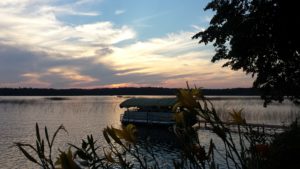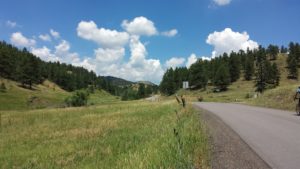We spouses at family reunions, especially when we‘ve only met the people once some 26 years ago, are often looking around the room for something to distract us from conversations that have no context for us.
We were in Aitkin, Minnesota, this weekend, commemorating the life of Irja Guinella Howe, nee Trast. She and my wife Karla’s mother Taimi were sisters. Irja outlived all her siblings, as many as a dozen when you count the ones who couldn’t survive the rough childhood on the dairy farm in nearby Palisade, a village then and now of just over 100 people. It was founded by migrating Finns who discovered that the flat terrain with rich soil and mosquitoes as large as starlings was much like their homeland. The entire town was a cooperative, a brand of socialism that they brought with them.
We gathered at Pine Lake, just south of Aitken, where the Howe family with all their cousins and the Leavelle/Trast clan would gather most summers. Taimi, with Karla, her sister Tanya and brother Jimmy, would drive from Dallas to Palisade, visit the grandparents and then settle into the Pine Lake cabin to find entertainment in the pre-digital era.
I listened to the stories, many like those we’ve all experienced with our cousins. When the cousins were young and went to the lake, there was simply too much undeveloped brain power and mischievousness for even a bevy of adults to manage. If no one drowns, all can be forgiven and laughed about decades later.
Karla had her own tales, like walking from the grandparents’ house, which was on the Mississippi River where it’s only about 30 yards wide and knee deep, to town to spend the 50 cents that was burning a hole in her pocket. Sometimes on the way back, the mailman would pull alongside and ask her if she wanted a ride home. He knew where everyone lived in town, even the visiting relatives. Today that act would get him arrested. Then, Karla accepted without hesitation.
Then there was the time Karla developed sharp stomach pains. The local doctor said it might be her appendix. Taimi, a nurse, wasn’t convinced, but said if she was to have them removed, it would be by a doctor at home. So off they went. Taimi drove straight through, a nearly 1,100-mile trip, before the interstate system and without air conditioning. As they crossed the Red River, Taimi commented, “We’ll, we’re in Texas. Almost home.” Karla’s pains ceased. Turned out, being a Daddy’s girl, she was just homesick.
The old farmhouse and barn were razed long ago. The sauna, a staple of Finnish families, had collapsed. We examined it and took a brick that formed the floor to bring back. The Mississippi looked exactly as it did 60 years ago, Karla said.
As the others traded stories I tried to remember everyone’s name. They came from all over. Irja’s four children settled in Detroit, rural Wisconsin, the west coast of Australia and Ulm, Germany. The German boys live in Germany, Switzerland and Bangkok. And they had children who spoke several languages. You needed a scorecard and Google Translate.
At first on Friday, it was overwhelming. I wondered if they really wanted me there. I was another mouth to feed and a fish out of water they tried valiantly to include and save from boredom. The second generation at least I knew by name and vaguely remembered meeting them all those years ago. They third generation were all kids back then. And they now had children of their own, some of whom didn’t speak English—or more likely pretended not to so they wouldn’t need to talk to silly adults who tried to engage them.
As I listened to Irja’s three boys, Gary, Mike and Dan, and daughter Jenny talk, they had obviously processed their grief about their mom. She had died a year ago, and having lived a century, most of it in good health and indomitable spirit, there was little regret. She had expressed a readiness to join her beloved Clark who had died nearly 30 years ago.
What they were having a tougher time processing was knowing that they would never again see the farmstead in Palisade, as the cousin who had inherited it was now 75 and ready to settle in San Antonio. They would likely never return to Pine Lake. They would never gather along its shores, watch the summer sunset and listen to the loons standing guard.
Saturday began with the memorial service. A couple of family members sang songs, one of which was “Everything Must Change,” a 1974 tune first recorded by Quincy Jones. It seemed fitting. The pastor at the small white clapboard chapel did his best to keep it upbeat with a few well-worn but appreciated jokes. One of the German boys, who had served as both video documentarian of the weekend and the chief cook and bottle washer, presented a video of his grandmother. It was a loving tribute to a woman who loved life and laughed often. The last section featured her speaking, singing and laughing on camera and finally as the group left whatever event he was recording, she looked at the camera, waved, and said, “Auf wiedersehen.”
A few us of went to the nearby cemetery where Clark lay. They had dug a small hole for Irja’s urn. Prayers were said. She was laid to rest and covered with dirt. I’m not religious, but rituals serve their purpose. They validate our journey from dust to dust and comfort those who carbon atoms are still fighting to survive.
We went back to the cabin, and poured whiskey, beer and wine. The sun had a few hours left, but it wouldn’t be enough. This would almost certainly be their last sunset at the lake, or in Minnesota, period.
But they had a plan. They would meet to celebrate milestone birthdays of two of the third generation, number 40 for one and for the oldest of that generation, a 50th. They wouldn’t have Pine Lake. They wouldn’t see the land where their mother’s parents saw Finland. But they would meet where maybe they could plant a flag that would hold a similar special meaning, Rottnest Island off Perth, Australia, where Gary settled and his three daughters live nearby. If that didn’t work, maybe the next year it would be Ulm.
I found myself warmed by this family. I loved seeing how important this place was to them, but also how their time together validated the ties that bind. Karla is part of that family, I’m not, yet I gained much. Before we left, I thanked them and told them how much I enjoyed seeing them bond again.
Not everything must change. Some things will endure.


